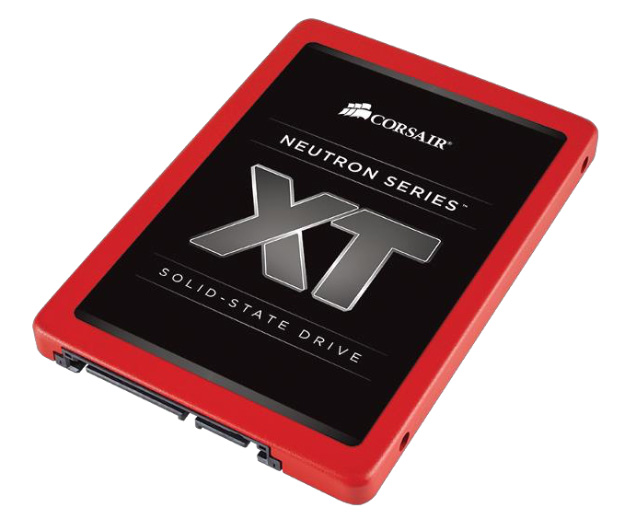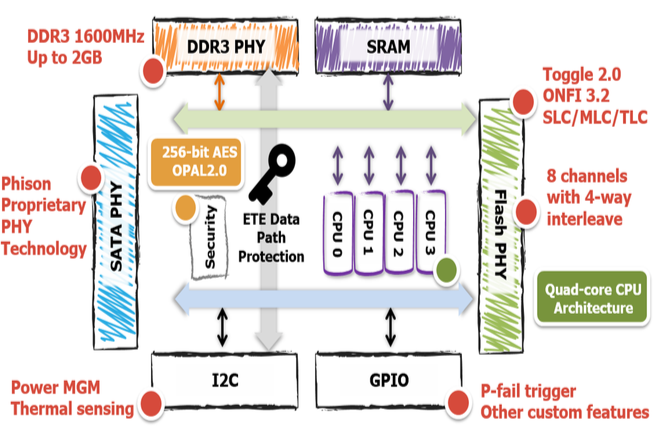Corsair Neutron XT (240GB, 480GB & 960GB) SSD Review: Phison S10 Debuts
by Kristian Vättö on November 17, 2014 9:00 AM EST
The ugly truth is that the SSD market has been tough for almost all the typical PC component vendors lately. With Samsung, SanDisk, and Micron/Crucial being serious about the client market, it's not easy for other companies to find a way to provide any substantial advantage over the big brands. The fab owners will always enjoy a cost advantage, which is why we have seen a few companies backing off from the market and many more for whom SSDs have become just another series in the pool of products.
This is what could be said to have happened at Corsair. While the company has never been super aggressive on the SSD side, the past year or so has been very quiet. There have been a couple of new releases, such as the Force LS and Force LX, but nothing close to the exclusive deal Corsair scored with Link A Media (LAMD) two years ago.
One way to perceive whether a company is serious about a specific model is with the media sampling process. If there is no embargo and only one capacity is available for review, then historically the product has not been a substantial or interesting release. If, on the other hand, there is an official release date and the manufacturer samples several of the available capacities, then this can be a sign that the product might be a bit more special. This is never a hard and fast rule, and it is always welcome to be surprised.
From the title, the Neutron XT from Corsair is a member of the latter case. This is the first time Corsair has offered us the full set of drives since the original Neutron and Neutron GTX, and the Neutron XT is the first drive to ship with Phison's new S10 controller.
Phison actually sent us reference design samples of the S10 prior to Corsair, but we were asked to review the Neutron XT first (as Corsair is a household name while Phison is pretty much the opposite). However, Phison asked us to save the technical analysis of the controller and its architecture for the separate reference design article, so I'll keep to the basic details for now; stay tuned for a more in-depth analysis of the S10 in the next two weeks.
The biggest change in the S10 compared to the S8 is the upgrade to a quad-core CPU architecture. Three of the cores are dedicated to internal flash management (garbage collection, wear-leveling etc.), whereas one will handle the host operations. The NAND channel count remains at eight like in the S8, which seems to have become the standard for client-grade controllers. Capacity support goes as high as 2TB and the S10 design can also support TLC NAND, although that is not fully ready yet.
| Corsair Neutron XT Specifications | ||||
| Capacity | 240GB | 480GB | 960GB | |
| Controller | Phison PS3110-S10 | |||
| NAND | Toshiba A19nm MLC | |||
| NAND Density | 64 Gbit per Die | 128 Gbit per Die | ||
| Sequential Read | Up to 560MB/s | |||
| Sequential Write | Up to 540MB/s | |||
| 4KB Random Read | Up to 100K IOPS | |||
| 4KB Random Write | Up to 90K IOPS | |||
| Encryption | N/A | |||
| Warranty | Five years | |||
| Availability | December | |||
EDIT: Corsair had an error in the reviewer's guide, so the warranty is actually five years similar to the original Neutron series.
Corsair is offering the Neutron XT in three capacities: 240GB, 480GB and 960GB. The Neutron brand has always been more of a high-end enthusiast/gamer brand, so it makes sense to skip the 120GB model because the majority of the target population will be aiming at 240GB at a minimum.
On the NAND front Corsair is using Toshiba's A19nm MLC NAND. The 240GB and 480GB models are equipped with 64Gbit dies to provide higher parallelism and performance, whereas the 960GB model has enough NAND on its own to provide the necessary parallelism and performance with a 128Gbit die.
Like many platforms on the market, the S10 features a page-level parity scheme that Phison calls 'Page RAID ECC Parity' to protect against NAND failures. Unfortunately Phison couldn't disclose the parity ratio (i.e. how much NAND is dedicated to parity), which makes calculating the exact over-provisioning impossible, but I was told that the feature only provides page-level protection and can't tolerate a full block or die failure.
Corsair is not announcing pricing yet because the drive is not officially launching until early December, which would subject the prices to fluctuation. However, I'll make sure to update this article with the pricing information once that becomes available.
Test Systems
For AnandTech Storage Benches, performance consistency, random and sequential performance, performance vs transfer size and load power consumption we use the following system:
| CPU | Intel Core i5-2500K running at 3.3GHz (Turbo & EIST enabled) |
| Motherboard | ASRock Z68 Pro3 |
| Chipset | Intel Z68 |
| Chipset Drivers | Intel 9.1.1.1015 + Intel RST 10.2 |
| Memory | G.Skill RipjawsX DDR3-1600 4 x 8GB (9-9-9-24) |
| Video Card | Palit GeForce GTX 770 JetStream 2GB GDDR5 (1150MHz core clock; 3505MHz GDDR5 effective) |
| Video Drivers | NVIDIA GeForce 332.21 WHQL |
| Desktop Resolution | 1920 x 1080 |
| OS | Windows 7 x64 |
Thanks to G.Skill for the RipjawsX 32GB DDR3 DRAM kit
For slumber power testing we used a different system:
| CPU | Intel Core i7-4770K running at 3.3GHz (Turbo & EIST enabled, C-states disabled) |
| Motherboard | ASUS Z87 Deluxe (BIOS 1707) |
| Chipset | Intel Z87 |
| Chipset Drivers | Intel 9.4.0.1026 + Intel RST 12.9 |
| Memory | Corsair Vengeance DDR3-1866 2x8GB (9-10-9-27 2T) |
| Graphics | Intel HD Graphics 4600 |
| Graphics Drivers | 15.33.8.64.3345 |
| Desktop Resolution | 1920 x 1080 |
| OS | Windows 7 x64 |
- Thanks to Intel for the Core i7-4770K CPU
- Thanks to ASUS for the Z87 Deluxe motherboard
- Thanks to Corsair for the Vengeance 16GB DDR3-1866 DRAM kit, RM750 power supply, Hydro H60 CPU cooler and Carbide 330R case













56 Comments
View All Comments
magnusmundus - Monday, November 17, 2014 - link
I think the SATA 3 SSD market is already saturated. Read/write speeds and IOPS are pretty much as good as they are going to get. The only thing left to do is increase capacity and reduce costs. Why not start releasing drives for the new SATA Express interface, or more M.2 form factor drives? Too small a Z97 market? I guess we'll have to wait another year or so.sweenish - Monday, November 17, 2014 - link
I personally vote for skipping m.2 altogether. Let's just move right on to the PCI-E drives.TinHat - Monday, November 17, 2014 - link
+1hrrmph - Monday, November 17, 2014 - link
I think you mean let's skip the M.2 drives that use the (slower) SATA protocol, and move right on to the M.2 drives that use the (faster) PCI-E protocol.Samus - Monday, November 17, 2014 - link
Right. I have a Samsung M.2 PCIE drive, and after finally getting it to boot on my H97 board (using a EFI boot manager partition on my SATA SSD to point to its windows installation) all I can tell you is 1100MB/sec is pretty insane. It loads BF4 maps so fast I'm always waiting on the server...Mikemk - Monday, November 17, 2014 - link
So you want to lose a GPU?shank15217 - Tuesday, November 18, 2014 - link
The protocol is called NVMe, a PCI-E drive doesn't mean much.r3loaded - Tuesday, November 18, 2014 - link
Actually both the legacy AHCI and the new NVMe protocols can be used on a PCIe-attached drive. The consumer Plextor M6e and Samsung XP941 use AHCI for compatibility reasons, while the new Intel server drives use NVMe for better performance in server workloads.Kristian Vättö - Monday, November 17, 2014 - link
Every single controller house is working on a PCIe controller for SATA Express and M.2, but the development takes time.warrenk81 - Monday, November 17, 2014 - link
honest question, not trying to be snarky, but how has apple been shipping PCIe SSDs for almost two years and no one else is?